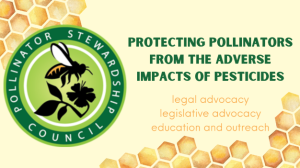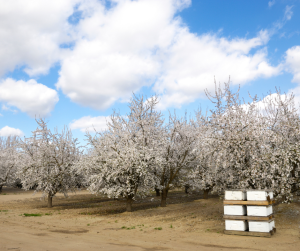 Bee Shortage in Almond Bloom
Bee Shortage in Almond Bloom
Almond production is a prime example of the critical role pollinators play in our fragile food system. California’s Central Valley produces 80% of the world’s almonds and growers are dependent on honeybees to provide pollination for this important crop. Bees are shipped from all over the country to provide pollination services, valued at an estimated $25 million annually.
 For the first time in 25 years, orchard space actually decreased but in spite of a reduction of approximately 60,000 acres, a shortage of bees during bloom will certainly impact crop yield in 2023. Predictions earlier this year indicated the acreage reduction could lead to an surplus of bees, causing prices to drop for hive rentals. Instead, it seems that beekeepers continue to struggle with significant losses and are struggling to keep up with demand even at a reduced level. Low-level chronic exposure to pesticides is linked to bee decline, and in the early spring, these weakened colonies are more susceptible to pathogens and parasites as they struggle to regain vigor and health after overwintering. Although there is a significant body of scientific evidence proving that neonicotinoids are responsible for pollinator losses, regulatory agencies continue to permit their use, creating a more fragile food system and causing food insecurity.
For the first time in 25 years, orchard space actually decreased but in spite of a reduction of approximately 60,000 acres, a shortage of bees during bloom will certainly impact crop yield in 2023. Predictions earlier this year indicated the acreage reduction could lead to an surplus of bees, causing prices to drop for hive rentals. Instead, it seems that beekeepers continue to struggle with significant losses and are struggling to keep up with demand even at a reduced level. Low-level chronic exposure to pesticides is linked to bee decline, and in the early spring, these weakened colonies are more susceptible to pathogens and parasites as they struggle to regain vigor and health after overwintering. Although there is a significant body of scientific evidence proving that neonicotinoids are responsible for pollinator losses, regulatory agencies continue to permit their use, creating a more fragile food system and causing food insecurity.
As beekeeper Dave Hackenberg explains, “Looking at bees all across the country, it’s not just a problem with the bees that overwintered in Florida or Texas or California, it’s not just a problem for bees out of controlled climate winter storage facilities. It’s a nationwide problem that goes back to what they were exposed to over the summer, with nearly 200 million acres planted in corn, cotton, and soybeans which are big users of systemic chemicals. Last summer the bees were stressed by exposure to pesticides, they carried it into the colony where they continued to be contaminated by it and were weakened over the winter. We put them in almonds where they needed to grow fast and build numbers but their bodies were in bad shape. A week or so after placing them in orchards, the bees just stopped flying. Calls started pouring in, folks looking for replacement bees but there were none.”








